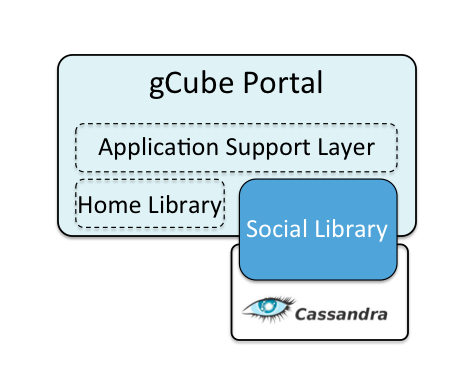Social Networking Library
Overview
The purpose of this document is to provide instructions for developers wishing to exploit Social Networking from within their applications.
The gCube Social Library, so far, provides methods for:
- Publishing Users Posts;
- Retrieving Users Feeds, Comments, Likes;
- Managing Users Connections;
- Publishing Users Notifications;
- Publishing Application News to User feeds.
Architecture Scenario
The gCube Social Networking Library is the 'bridge' between your gCube Applications and the social networking facilities. The social networking facilities exploit a NoSQL data store for their storage. Specifically an Apache Cassandra data store. Figure 1 present the place of the Social Library in a simplified gCube Portal architecture.
How to use the gCube Social Networking Library (SNL)
Your gCube Application will the SNL through a specific ASL Extension, the ASL Social Extension
ASL Social Extension
The ASL Social Extension is formed by different modules, each of these is delegated to one specific task. Every module inherits from a super class called SocialPortalBridge. Currently there are two modules available:
- Application News Manager: to be used by gCube Applications when they need to post news on their user news feeds;
- User Notifications Manager: to be used by gCube Applications when they need to notify their users about some events.
Application News Manager
- Create Your Application Profile
In order to publish a news from within your application you first need to create an Application Profile for your gCube Application. You need to create Generic Resource in of secondary type 'ApplicationProfile' having your application name as resource name in the Root Scope. You will also need to provide additional information in the body of your Generic Resource.
An Application Profile needs to provide the following information:
- Name
- Description
- Unique Identifier
- Thumbnail image URL
- Endpoints
In the following an example of an Application Profile is reported for the Share Updates Application Portlet:
<Resource version="0.4.x"> <ID>dec27470-447e-11e2-a749-e3b17e68146a</ID> <Type>GenericResource</Type> <Scopes> <!-- The Generic Resource scope must be the Root VO --> <Scope>/gcube</Scope> </Scopes> <Profile> <!-- The Generic Resource SecondaryType must be ApplicationProfile --> <SecondaryType>ApplicationProfile</SecondaryType> <Name>Share Updates Application</Name> <Description>desc for Share Updates Application</Description> <Body> <!-- The App Id is your servlet class name --> <AppId>org.gcube.portlets.user.shareupdate.server.ShareUpdateServiceImpl</AppId> <ThumbnailURL>http://www.eprcreations.com/wp-content/uploads/2012/10/twitter_linkedin.png</ThumbnailURL> <!-- The EndPoints of your application with the absolute path to reach it, one for every scope in which the application is deployed --> <EndPoint> <Scope>/gcube/devsec/devVRE</Scope> <URL>/group/devvre/share-update</URL> </EndPoint> <EndPoint> <Scope>/gcube/devNext/NextNext</Scope> <URL>/group/nextnext/share</URL> </EndPoint> </Body> </Profile> </Resource>
The <body> part of your Generic Resource must be compliant with the following xml schema, available in this File:SampleApplicationProfile.xsd in case you need.
<?xml version="1.0" encoding="UTF-8"?> <xs:schema xmlns:xs="http://www.w3.org/2001/XMLSchema" elementFormDefault="qualified"> <xs:element name="body"> <xs:complexType> <xs:sequence> <xs:element ref="AppId"/> <xs:element ref="ThumbnailURL"/> <xs:element maxOccurs="unbounded" ref="EndPoint"/> </xs:sequence> </xs:complexType> </xs:element> <xs:element name="AppId" type="xs:string"/> <xs:element name="ThumbnailURL" type="xs:anyURI"/> <xs:element name="EndPoint"> <xs:complexType> <xs:sequence> <xs:element ref="scope"/> <xs:element ref="URL"/> </xs:sequence> </xs:complexType> </xs:element> <xs:element name="scope" type="xs:string"/> <xs:element name="URL" type="xs:string"/> </xs:schema>
- Instantiate the News Manager from your Application
The signature of the ApplicationNewsManager Constructor is the following:
ApplicationNewsManager(ASLSession session, Class<? extends HttpServlet> applicationClass)
In the following the ApplicationNewsManager is instantiated by the Share Updates Application servlet class:
package org.gcube.portlets.user.shareupdate.server; .... ** * The server side implementation of the RPC service. */ @SuppressWarnings("serial") public class ShareUpdateServiceImpl extends RemoteServiceServlet implements ShareUpdateService { ........ NewsManager anm = new ApplicationNewsManager(getASLSession(), this.getClass()); .......
